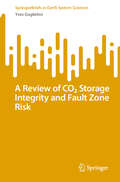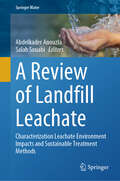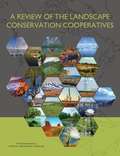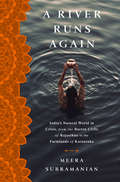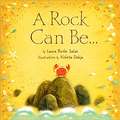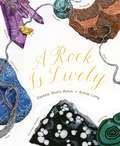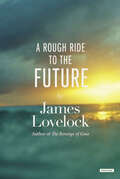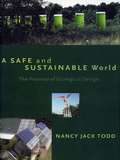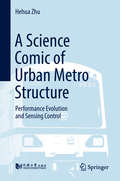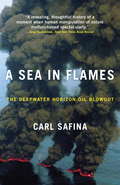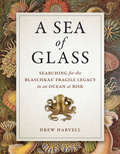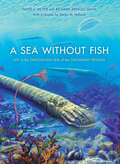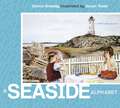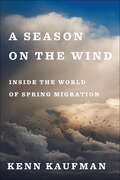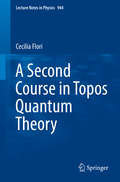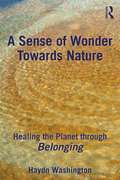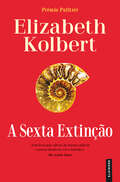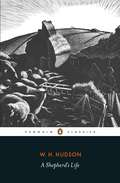- Table View
- List View
A Review of CO₂ Storage Integrity and Fault Zone Risk (SpringerBriefs in Earth System Sciences)
by Yves GuglielmiThis book compares how seismic fault activation can be described by frictional-based theories such as the rate and state theory or by a general dynamic plasticity approach such as the Cam-Clay theory. In this book, the leading edge of fault physics concepts that are best suited and applicable to assess the risk of leakage and induced seismicity associated with large-scale CO₂ storage in sedimentary basins are explored. It compares the hydromechanical response of faults under deviatoric loading at laboratory, field experiment and basin scales. A review of some key parameters that drive the brittle-ductile behavior of faults affecting the reservoir-caprock system is presented. It is suggested that more general plastic criteria than the Coulomb failure should be used to better account for the ratio between the bulk plasticity and localized frictional strength of a fault zone. Based on new field data, it is shown that most of the fault permeability increase occurs at the onset of activation due to bulk dilation, whereas shearing has less impact on the permeability. This is different from laboratory observations where shearing often results in strong permeability reductions. This last part leads to some new concepts that have not been discussed to date, such as the possibility of slow fault movements eventually evolving to earthquakes at timescales of years to decades, thus relevant to the time life of CO₂ storage permits.
A Review of Landfill Leachate: Characterization Leachate Environment Impacts and Sustainable Treatment Methods (Springer Water)
by Salah Souabi Abdelkader AnouzlaSolid waste landfilling and related environmental issues have become global concerns, particularly in developing countries. Accelerating population growth and changing lifestyles have exacerbated health and environmental challenges. This book looks at the global ramifications of leachate characterization and environmental impacts, highlighting the different issues related to landfilling, such as leachate generation and its constituents. When water enters a landfill, it assimilates the dissolved components of the decomposing waste, thus forming a leachate with considerable impacts on the environment. The nature of the landfill and the waste received (household waste alone or mixed with industrial waste) determine whether the leachate produced is hazardous or not. The decomposition of solid waste in landfills goes through several stages, including an initial aerobic phase, an anaerobic acid phase, an initial methanogenic phase and a stable methanogenic phase. Leachates can contain significant concentrations of heavy metals, inorganic salts, ammonia, halogenated hydrocarbons, suspended matter, organic pollutants in significant quantities... Generally, leachate discharges are rich in phenol, highly toxic polluting ammonium. Ecotoxicological assessment of this effluent is essential to determine the impact of its contaminants on the aquatic ecosystem. If pollutants are not disposed of properly, leachate from landfills can potentially enter soils and subsoils, severely contaminating surface and groundwater bodies. Therefore, reducing pollutant levels through leachate treatment has garnered considerable attention in recent decades. This publication is an invaluable resource, providing up-to-date information on the impact and characterization of leachate landfills. It is therefore time to accentuate the training of executives with all the skills to facilitate the waste management through the research efforts of academics, in the field of solid wastelandfill operations.
A Review of the Landscape Conservation Cooperatives
by Engineering Medicine National Academies of SciencesThe United States' tradition of conserving fish, wildlife, habitats, and cultural resources dates to the mid-19th century. States have long sought to manage fish and wildlife species within their borders, whereas many early federal conservation efforts focused on setting aside specific places as parks, sanctuaries, or reserves. With advances in landscape ecology over the past quarter-century, conservation planners, scientists, and practitioners began to stress the importance of conservation efforts at the scale of landscapes and seascapes. These larger areas were thought to harbor relatively large numbers of species that are likely to maintain population viability and sustain ecological processes and natural disturbance regimes - often considered critical factors in conserving biodiversity. By focusing conservation efforts at the level of whole ecosystems and landscape, practitioners can better attempt to conserve the vast majority of species in a particular ecosystem. Successfully addressing the large-scale, interlinked problems associated with landscape degradation will necessitate a planning process that bridges different scientific disciplines and across sectors, as well as an understanding of complexity, uncertainty, and the local context of conservation work. The landscape approach aims to develop shared conservation priorities across jurisdictions and across many resources to create a single, collaborative conservation effort that can meet stakeholder needs. Conservation of habitats, species, ecosystem services, and cultural resources in the face of multiple stressors requires governance structures that can bridge the geographic and jurisdictional boundaries of the complex socio-ecological systems in which landscape-level conservation occurs. The Landscape Conservation Cooperatives (LCC) Network was established to complement and add value to the many ongoing state, tribal, federal, and nongovernmental efforts to address the challenge of conserving species, habitats, ecosystem services, and cultural resources in the face of large-scale and long-term threats, including climate change. A Review of the Landscape Conservation Cooperatives evaluates the purpose, goals, and scientific merits of the LCC program within the context of similar programs, and whether the program has resulted in measurable improvements in the health of fish, wildlife, and their habitats.
A Review of the U.S. Global Change Research Program's Strategic Plan
by National Research Council Division of Behavioral and Social Sciences and Education Board on Environmental Change and Society Division on Earth and Life Studies Committee to Advise the U.S. Global Change Research Program Board on Atmospheric Sciences and ClimateThe U.S. government supports a large, diverse suite of activities that can be broadly characterized as "global change research." Such research offers a wide array of benefits to the nation, in terms of protecting public health and safety, enhancing economic strength and competitiveness, and protecting the natural systems upon which life depends. The U.S. Global Change Research Program (USGCRP), which coordinates the efforts of numerous agencies and departments across the federal government, was officially established in 1990 through the U.S. Global Change Research Act (GCRA). In the subsequent years, the scope, structure, and priorities of the Program have evolved, (for example, it was referred to as the Climate Change Science Program [CCSP] for the years 2002-2008), but throughout, the Program has played an important role in shaping and coordinating our nation's global change research enterprise. This research enterprise, in turn, has played a crucial role in advancing understanding of our changing global environment and the countless ways in which human society affects and is affected by such changes. In mid-2011, a new NRC Committee to Advise the USGCRP was formed and charged to provide a centralized source of ongoing whole-program advice to the USGCRP. The first major task of this committee was to provide a review of the USGCRP draft Strategic Plan 2012-2021 (referred to herein as "the Plan"), which was made available for public comment on September 30, 2011. A Review of the U.S. Global Change Research Program's Strategic Plan addresses an array of suggestions for improving the Plan, ranging from relatively small edits to large questions about the Program's scope, goals, and capacity to meet those goals. The draft Plan proposes a significant broadening of the Program's scope from the form it took as the CCSP. Outlined in this report, issues of key importance are the need to identify initial steps the Program will take to actually achieve the proposed broadening of its scope, to develop critical science capacity that is now lacking, and to link the production of knowledge to its use; and the need to establish an overall governance structure that will allow the Program to move in the planned new directions.
A River Ran Wild: An Environmental History
by Lynne CherryAn environmental history of the Nashua River, from its discovery by Indians through the polluting years of the Industrial Revolution to the ambitious cleanup that revitalized it.
A River Runs Again: India's Natural World in Crisis, from the Barren Cliffs of Rajasthan to the Farmlands of Karnataka
by Meera SubramanianCrowded, hot, subject to violent swings in climate, with a government unable or unwilling to face the most vital challenges, the rich and poor increasingly living in worlds a∂ for most of the world, this picture is of a possible future. For India, it is the very real present. In this lyrical exploration of life, loss, and survival, Meera Subramanian travels in search of the ordinary people and microenterprises determined to revive India’s ravaged natural world: an engineer-turned-farmer brings organic food to Indian plates; villagers resuscitate a river run dry; cook stove designers persist on the quest for a smokeless fire; biologists bring vultures back from the brink of extinction; and in Bihar, one of India’s most impoverished states, a bold young woman teaches adolescents the fundamentals of sexual health. While investigating these five environmental challenges, Subramanian discovers the stories that renew hope for a nation with the potential to lead India and the planet into a sustainable and prosperous future.
A Rock Can Be (Millbrook Picture Books)
by Laura Purdie Salas Violeta DabijaRocks may seem like boring, static objects—until you discover that a rock can spark a fire, glow in the dark, and provide shelters of all shapes and sizes. Laura Purdie Salas's lyrical rhyming text and Violeta Dabija's glowing illustrations show how rocks decorate and strengthen the world around them.
A Rock Is Born: An Epic Journey Through Time
by Richard HoFollow the epic life cycle of one rock from its prehistoric creation to modern day, in this transportive nonfiction picture book perfect for fans of GRAND CANYON and the Over and Under series.Over one hundred million years ago, on the side of a volcano....a rock is born.As time passes and the world changes, the rock changes, too. Mud erodes it. Lava melts it. And water compresses it.Eventually, the rock will be reshaped. And a new rock is born.Award-winning creators Richard Ho and Lily Williams bring to life an evocative and educational picture book about the life cycle of a rock in this bold nonfiction tale perfect for any classroom or bookshelf.
A Rock Is Lively
by Dianna Hutts Aston Sylvia LongFrom the award-winning creators of An Egg Is Quiet, A Seed Is Sleepy, and A Butterfly Is Patient comes a gorgeous and informative introduction to the fascinating world of rocks. From dazzling blue lapis lazuli to volcanic snowflake obsidian, an incredible variety of rocks are showcased in all their splendor. Poetic in voice and elegant in design, this book introduces an array of facts, making it equally perfect for classroom sharing and family reading.
A Rough Ride to the Future
by James LovelockThe great scientific visionary of our age presents a radical vision of humanity’s future as the thinking brain of our Earth-system.A Rough Ride to the Future introduces two new Lovelockian ideas. The first is that three hundred years ago, when Thomas Newcomen invented the steam engine, he was unknowingly beginning what James Lovelock calls “accelerated evolution.” That is a process that is bringing about change on our planet roughly a million times faster than Darwinian evolution. The second idea is that as part of this process, humanity has the capacity to become the intelligent part of Gaia, the self-regulating earth system whose discovery Lovelock first announced nearly fifty years ago. A Rough Ride to theFuture is also an intellectual autobiography, in which Lovelock reflects on his life as a lone scientist and asks—eloquently—whether his career trajectory is possible in an age of increased bureaucratization. We are now changing the atmosphere again, and Lovelock argues that there is little that can be done about this. But instead of feeling guilty, we should recognize what is happening, prepare for change, and ensure that we survive as a species so we can contribute to—perhaps even guide—the next evolution of Gaia. The road will be rough, but if we are smart enough, life will continue on earth in some form far into the future.Praise for A Rought Ride to the Future“Arresting and disturbing . . . Lovelock writes wonderfully well. With the authority of age, his voice is that of an elder statesman . . . The result is mellifluous and fluent.” —Nature “Though the subject matter could scarcely be more discouraging, Lovelock’s fluent prose and vast range of knowledge make it a surprisingly easy read. . . . His writing has enormous warmth and vitality.” —Financial Times “The most important book for me this year . . . Lovelock is the most prescient of scientists. . . . He has given us a handbook for human survival.” —John Gray, The Guardian“Not simply another look at Mother Nature’s uncertain future, but a revealing glimpse at the life of an outspoken and accomplished man of ideas.” —Publishers Weekly
A Safe and Sustainable World: The Promise Of Ecological Design
by Nancy Jack ToddIn the late sixties, as the world awoke to a need for Earth Day, a pioneering group founded a small non-profit research and education organization they called the New Alchemy Institute. Their aim was to explore the ways a safer and more sustainable world could be created. In the ensuing years, along with scientists, agriculturists, and a host of enthusiastic amateurs and friends, they set out to discover new ways that basic human needs--in the form of food, shelter, and energy--could be met. A Safe and Sustainable World is the story of that journey, as it was and as it continues to be.The dynamics and the resilience of the living world were the Institute's model and inspiration for their research. Central to their efforts then and now is, along with science, a spiritual quest for a more harmonious human role in our planet's future. The results of this work have now entered mainstream science through the emerging discipline of ecological design.Nancy Jack Todd relates a fascinating journey from lofty ideals through the hard realities encountered in learning how to actually grow food, harness the energy of the sun and wind, and design green architecture. She also introduces us to some of the heroes and mentors who played a vital role in those efforts, from Buckminster Fuller to Margaret Mead.Successfully proving through the Institute's designs and investigations that basic land sustainability is achievable, John Todd and the author founded a second non-profit research group, Ocean Arks International. A Safe and Sustainable World demonstrates what has, can, and must be done to integrate human ingenuity and four billion years of evolutionary intelligence into healthy, decentralized, local dreams.
A Science Comic of Urban Metro Structure: Performance Evolution and Sensing Control
by Hehua ZhuThis science comic presents the entire life cycle of the metro system in an accessible and fun way. Just like human beings, a metro system can get sick, and this book introduces its ailments, medical records along with experts’ diagnoses and available treatments. Using cartoons, it enables readers of all levels to quickly understand the scientific secrets behind the metro system. It is based on the results of China’s 973 program, which aims to promote and develop basic scientific research in China.
A Sea in Flames: The Deepwater Horizon Oil Blowout
by Carl SafinaCarl Safina has been hailed as one of the top 100 conservations of the 20th century (Audubon Magazine) andA Sea in Flamesis his blistering account of the months-long manmade disaster that tormented a region and mesmerized the nation. Traveling across the Gulf to make sense of an ever-changing story and its often-nonsensical twists, Safina expertly deconstructs the series of calamitous misjudgments that caused theDeepwater Horizonblowout, zeroes in on BP’s misstatements, evasions, and denials, reassesses his own reaction to the government’s crisis handling, and reviews the consequences of the leak-and what he considers the real problems, which the press largely overlooked. Safina takes us deep inside the faulty thinking that caused the lethal explosion. We join him on aerial surveys across an oil-coated sea. We confront pelicans and other wildlife whose blue universe fades to black. Safina skewers the excuses and the silly jargon-like “junk shot” and “top kill”-that made the tragedy feel like a comedy of horrors-and highlighted Big Oil’s appalling lack of preparedness for an event that was inevitable. Based on extensive research and interviews with fishermen, coastal residents, biologists, and government officials,A Sea In Flameshas some surprising answers on whether it was “Obama’s Katrina,” whether the Coast Guard was as inept in its response as BP was misleading, and whether this worst unintended release of oil in history was really America’s worst ecological disaster. Impassioned, moving, and even sharply funny,A Sea in Flamesis ultimately an indictment of America’s main addiction. Safina writes: “In the end, this is a chronicle of a summer of pain-and hope. Hope that the full potential of this catastrophe would not materialize, hope that the harm done would heal faster than feared, and hope that even if we didn’t suffer the absolutely worst-we’d still learn the big lesson here. We may have gotten two out of three. That’s not good enough. Because: there’ll be a next time. ” From the Hardcover edition.
A Sea of Glass: Searching for the Blaschkas' Fragile Legacy in an Ocean at Risk (Organisms and Environments #13)
by Drew HarvellIt started with a glass octopus. Dusty, broken, and all but forgotten, it caught Drew Harvell's eye. Fashioned in intricate detail by the father-son glassmaking team of Leopold and Rudolf Blaschka, the octopus belonged to a menagerie of unusual marine creatures that had been packed away for decades in a storage unit. More than 150 years earlier, the Blaschkas had been captivated by marine invertebrates and spun their likenesses into glass, documenting the life of oceans untouched by climate change and human impacts. Inspired by the Blaschkas' uncanny replicas, Harvell set out in search of their living counterparts. In A Sea of Glass, she recounts this journey of a lifetime, taking readers along as she dives beneath the ocean's surface to a rarely seen world, revealing the surprising and unusual biology of some of the most ancient animals on the tree of life. On the way, we glimpse a century of change in our ocean ecosystems and learn which of the living matches for the Blaschkas' creations are, indeed, as fragile as glass. Drew Harvell and the Blaschka menagerie are the subjects of the documentary Fragile Legacy, which won the Best Short Film award at the 2015 Blue Ocean Film Festival & Conservation Summit. Learn more about the film and check out the trailer here. See the Blaschka collection in person at the Corning Museum of Glass beginning in May 2016. Click here for more information.
A Sea without Fish: Life in the Ordovician Sea of the Cincinnati Region (Life of the Past)
by Richard Arnold Davis David L. MeyerA “superbly written, richly illustrated” guide to the animals who lived 450 million years ago—in the fossil-rich area where Cincinnati, Ohio now stands (Rocks & Minerals).The region around Cincinnati, Ohio, is known throughout the world for the abundant and beautiful fossils found in limestones and shales that were deposited as sediments on the sea floor during the Ordovician Period, about 450 million years ago—some 250 million years before the dinosaurs lived. In Ordovician time, the shallow sea that covered much of what is now the North American continent teemed with marine life. The Cincinnati area has yielded some of the world’s most abundant and best-preserved fossils of invertebrate animals such as trilobites, bryozoans, brachiopods, molluscs, echinoderms, and graptolites.So famous are the Ordovician fossils and rocks of the Cincinnati region that geologists use the term “Cincinnatian” for strata of the same age all over North America. This book synthesizes more than 150 years of research on this fossil treasure-trove, describing and illustrating the fossils, the life habits of the animals represented, their communities, and living relatives, as well as the nature of the rock strata in which they are found and the environmental conditions of the ancient sea.“A fascinating glimpse of a long-extinct ecosystem.” —Choice
A Search for Muon Neutrino to Electron Neutrino Oscillations in the MINOS Experiment (Springer Theses)
by Juan Pedro Ochoa-RicouxThe centerpiece of the thesis is the search for muon neutrino to electron neutrino oscillations which would indicate a non-zero mixing angle between the first and third neutrino generations (θ13), currently the "holy grail" of neutrino physics. The optimal extraction of the electron neutrino oscillation signal is based on the novel "library event matching" (LEM) method which Ochoa developed and implemented together with colleagues at Caltech and at Cambridge, which improves MINOS' (Main Injector Neutrino Oscillator Search) reach for establishing an oscillation signal over any other method. LEM will now be the basis for MINOS' final results, and will likely keep MINOS at the forefront of this field until it completes its data taking in 2011. Ochoa and his colleagues also developed the successful plan to run MINOS with a beam tuned for antineutrinos, to make a sensitive test of CPT symmetry by comparing the inter-generational mass splitting for neutrinos and antineutrinos. Ochoa's in-depth, creative approach to the solution of a variety of complex experimental problems is an outstanding example for graduate students and longtime practitioners of experimental physics alike. Some of the most exciting results in this field to emerge in the near future may find their foundations in this thesis.
A Seaside Alphabet (ABC Our Country)
by Donna GrassbyWhether it’s a treasure hunt on Jewell Island, Maine, a sunny afternoon on the rocks at Peggy’s Cove, Nova Scotia, or a dip in the ocean on Prince Edward Island, life by the sea is fun. This gloriously illustrated picture book is a celebration of all things coastal: humpback whales, teeming wildlife, and most of all, people who make their homes by the ocean. Seaside life is shown in twenty-six magnificent illustrations. The alliterative text and the detailed notes at the back make the book as informative as it is beautiful. For those lucky enough to have visited the coast, as well as those who only dream of the sea, this book is a feast for the eyes and for the spirit.
A Season of Flowers (Tilbury House Nature Book #0)
by Michael GarlandMichael Garland (Daddy Played the Blues) displays his impressive illustration range with the stylized, country-quilt, digital collage illustrations of A Season of Flowers. Snowdrops and crocuses yield to tulips and hyacinths, then dogwood blossoms, iris, lupine, daisies, morning glories, daylilies, geraniums, peonies, sunflowers, roses, and chrysanthemums as spring passes to summer, then autumn. At last the garden slumbers into winter under a blanket of snow, preparing next year’s procession of blooms. Like actors crossing a stage, flowers narrate the passing seasons in the first person, each one briefly proclaiming its unique and vital role in the natural world. Backmatter descriptions complete this child’s introduction to a garden year, in which the passage of time is vividly realized. Fountas & Pinnell Level L
A Season on the Wind: Inside the World of Spring Migration
by Kenn KaufmanA close study of one season along Lake Erie that reveals the amazing science and magic of spring bird migration, and the perils of human encroachment. “Kenn Kaufman knows his birds and their miraculous journeys—and he feels them deeply, too. An enlightening, thought-provoking, and poignant read.” —Jennifer Ackerman, author of The Genius of BirdsEvery spring, billions of birds sweep north, driven by ancient instincts to return to their breeding grounds. This vast parade often goes unnoticed, except in a few places where these small travelers concentrate in large numbers. One such place is along Lake Erie in northwestern Ohio. There, the peak of spring migration is so spectacular that it attracts bird watchers from around the globe, culminating in one of the world’s biggest birding festivals. Millions of winged migrants pass through the region, some traveling thousands of miles, performing epic feats of endurance and navigating with stunning accuracy. Now climate change threatens to disrupt patterns of migration and the delicate balance between birds, seasons, and habitats. But wind farms—popular as green energy sources—can be disastrous for birds if built in the wrong places. This is a fascinating and urgent study of the complex issues that affect bird migration.“Kaufman soars above his Ohio home place and artfully shares the world of birds and the miraculous feats of migration that persist amidst constant conservation struggles and hard-won successes.” —J. Drew Lanham, author of The Home Place“A Season on the Wind will transform the way we see birds and the season of spring!” —Melissa Groo, wildlife photographer and conservationist
A Second Course in Topos Quantum Theory
by Cecilia FloriThis advanced course, a sequel to the first volume of this lecture series on topos quantum theory, delves deeper into the theory, addressing further technical aspects and recent advances. These include, but are not limited to, the development of physical quantities and self-adjoint operators; insights into the quantization process; the description of an alternative, covariant version of topos quantum theory; and last but not least, the development of a new concept of spacetime. The book builds on the concepts introduced in the first volume (published as Lect. Notes Phys. 868), which presents the main building blocks of the theory and how it could provide solutions to interpretational problems in quantum theory, such as: What are the main conceptual issues in quantum theory? And how can these issues be solved within a new theoretical framework of quantum theory? These two volumes together provide a complete, basic course on topos quantum theory, offering a set of mathematical tools to readers interested in tackling fundamental issues in quantum theory in general, and in quantum gravity in particular. From the reviews of the first volume: The book is self-contained and can be used as a textbook or self-study manual teaching the usage of category theory and topos theory, in particular in theoretical physics or in investigating the foundations of quantum theory in mathematically rigorous terms. [The] book is a very welcome contribution. Frank Antonsen, Mathematical Reviews, December, 2013
A Sense of Urgency: How the Climate Crisis Is Changing Rhetoric
by Debra HawheeA study of how the climate crisis is changing human communication from a celebrated rhetorician. Why is it difficult to talk about climate change? Debra Hawhee argues that contemporary rhetoric relies on classical assumptions about humanity and history that cannot conceive of the present crisis. How do we talk about an unprecedented future or represent planetary interests without privileging our own species? A Sense of Urgency explores four emerging answers, their sheer novelty a record of both the devastation and possible futures of climate change. In developing the arts of magnitude, presence, witness, and feeling, A Sense of Urgency invites us to imagine new ways of thinking with our imperiled planet.
A Sense of Wonder Towards Nature: Healing the Planet through Belonging
by Haydn WashingtonEnvironmental scientist and writer Haydn Washington argues that we will not solve the environmental crisis unless we change our worldview and ethics, and to do so we must rejuvenate our sense of wonder at nature. This book focuses on humanity’s relation with nature, and the sense of wonder and belonging common to indigenous cultures and children everywhere. Drawing on events in the author’s own four decades working to protect wild places, and the current literature on wonder, it examines what a sense of wonder is, what it has been called in different cultures, and our high points of wonder at nature. It also looks at the ‘Great Divide’ in worldview between anthropocentrism and ecocentrism, and considers the problem of anthropocentric theory in academia, arguing that the focus should instead be on harmony with nature. The book concludes with an examination of why wonder has become buried in Western society and considers ways in which it can be revived, including rituals and education. It also considers how wonder helps humanity to become ‘whole’. The final chapter presents the road back to wonder and how wonder towards nature can be restored in Western society. This book will be of great interest to environmental scientists, conservation biologists, environmental philosophers and ecological ethicists, as well as environmentalists, educators, eco-psychologists, and students looking at sustainability, deep ecology, and environmental philosophy and ethics.
A Sexta Extinção
by Elizabeth KolbertLeitura recomendada por Yuval Noah Harari, Al Gore, Bill Gates e Barack Obama, A Sexta Extinção é considerado um dos livros de divulgação científica mais importantes dos últimos anos, tendo sido finalista do National Book Critics Award e vencedor do Prémio Pulitzer para obras de não-ficção. Nos últimos 500 milhões de anos, a Terra passou por cinco extinções em massa, nas quais a diversidade da vida no planeta se reduziu drástica e subitamente. Atualmente, e pela primeira vez na História, decorre um processo de extinção em massa provocado por uma única espécie: o Homem. Nos últimos dois séculos, provocámos danos irreparáveis no clima e ecossistema global; como consequência direta, mais de um quarto de todos os mamíferos da Terra está hoje em vias de extinção, tal como acontece com 40% dos anfíbios, um terço dos corais e dos tubarões, um quinto dos répteis e um sexto das aves. Considerado um dos livros de divulgação científica mais relevantes dos últimos anos, A Sexta Extinção é leitura recomendada por personalidades como YuvalNoah Harari, Al Gore, Bill Gates ou Barack Obama. Neste seu valioso trabalho, Elizabeth Kolbert combina os resultados de uma extensa investigação no terreno com a história das ideias e o trabalho de geólogos, botânicos e biólogos marinhos, produzindo um documento inédito e, mais do que isso, um apelo urgente para que, repensando o nosso papel no planeta, não deixemos como derradeiro legado uma sexta extinção. «Um livro maravilhoso e um aviso muito claro de que mudanças repentinas são possíveis de ocorrer. Já aconteceram no passado e podem vir a repetir-se.» Barack Obama «Um livro que altera de forma radical o nosso modo de ver o mundo.» The Seattle Times «As longas viagens que Elizabeth Kolbert realizou durante a pesquisa para este livro e o tratamento detalhado tanto dos factos históricos como dos científicos, fazem de A Sexta Extinção um contributo muito valioso para a compreensão das nossas circunstâncias atuais.» Al Gore, The New York Times Book Review «Kolbert mostra nestas páginas que é capaz de escrever poeticamente sobre os animais em vias de extinção, mas o verdadeiro poder deste livro reside nos factos científicos e no contexto histórico apresentados pela autora, ao documentar as perdas crescentes que o Homem está a provocar.» The New York Times
A Shepherd's Life
by W. H. HudsonConsidered a classic at the time of its publication in 1910, A Shepherd's Life is a rare account of the lives of those who lived on and worked the land in nineteenth-century rural Britain. A masterful work of prose, W. H. Hudson focuses on the story of one man, a Wiltshire shepherd named Caleb Bawcombe, whose tales of sheep dogs, farmer's wives, poachers and local fairs become a sublime account of a way of life that has largely disappeared from these shores.
A Short Guide to Climate Change Risk (Short Guides to Business Risk)
by Nigel ArnellClimate change poses a risk to business operations and to markets, and a poor business response to this risk can lead to reputational damage, or worse. At the same time, climate change can bring opportunities for some businesses. In this addition to Gower’s series of Short Guides to Business Risk, Professor Arnell, one of the world’s leading experts in the field, reviews this critical area of risk posed to businesses and other organisations by climate change and considers how they can respond to this threat. A Short Guide to Climate Change Risk focuses on the impacts and consequences of climate change rather than on business use of energy or business and 'sustainability' issues. The author examines the advantages and disadvantages of different approaches to addressing these risks, with international case study examples. With chapters on the nature, science and politics of climate change, on the assessment and management of climate change risks, and recommendations for incorporating climate change risks into a Company Risk Management System, this concise guide serves the needs of business students and practitioners across a wide range of sectors, public and private.
